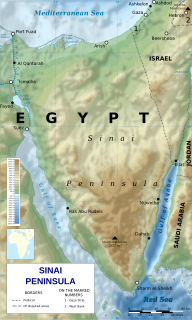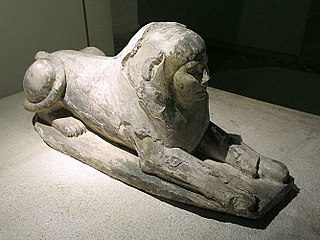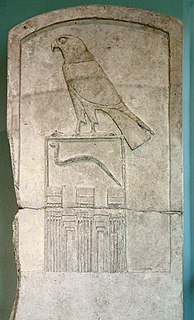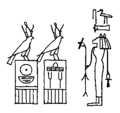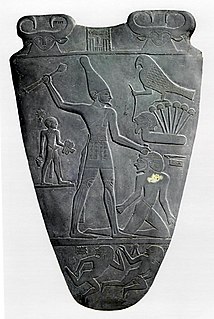
Narmer was an ancient Egyptian king of the Early Dynastic Period, circa 3100-3050 BC. He probably was the successor to the Protodynastic king Ka, or possibly Scorpion. Some consider him the unifier of Egypt and founder of the First Dynasty, and in turn the first king of a unified Egypt.

Hotepsekhemwy is the Horus name of an early Egyptian king who was the founder of the 2nd dynasty. The exact length of his reign is not known; the Turin canon suggests an improbable 95 years while the Ancient Egyptian historian Manetho reports that the reign of "Boëthôs" lasted for 38 years. Egyptologists consider both statements to be misinterpretations or exaggerations. They credit Hotepsekhemwy with either a 25- or a 29-year rule.

Qa'a was the last king of the First Dynasty of Egypt. He reigned for 33 years at the end of the 30th century BC.
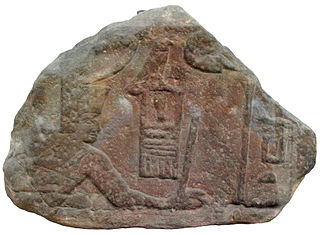
Sanakht was an ancient Egyptian king (pharaoh) of the Third Dynasty during the Old Kingdom. His chronological position is highly uncertain, and it is also unclear under which Hellenized name the ancient historian Manetho could have listed him. Many Egyptologists connect Sanakht with the Ramesside cartouche name Nebka. However, this remains disputable, because no further royal title of that king was ever found; neither in contemporary sources, nor in later ones. There are two relief fragments depicting Sanakht that once originated from the Wadi Maghareh on the Sinai Peninsula.

Djer is considered the third pharaoh of the First Dynasty of ancient Egypt in current Egyptology. He lived around the mid-thirty-first century BC and reigned for c. 40 years. A mummified forearm of Djer or his wife was discovered by Flinders Petrie, but was discarded by Émile Brugsch.

Nynetjer is the Horus name of the third pharaoh of the Second Dynasty of Egypt. The length of his reign is unknown. The Turin Canon suggests an improbable reign of 96 years and Egyptian historian Manetho suggested that Nynetjer's reign lasted 47 years. Egyptologists question both statements as misinterpretations or exaggerations. They generally credit Nynetjer with a reign of either 43 years or 45 years. Their estimation is based on the reconstructions of the well known Palermo Stone inscription reporting the years 7–21, the Cairo Stone inscription reporting the years 36–44. According to different authors, Nynetjer ruled Egypt from c. 2850 BC to 2760 BC or later from c. 2760 BC to 2715 BC.

Khaba was a pharaoh of Ancient Egypt, active during the 3rd dynasty of the Old Kingdom period. The exact time during which Khaba ruled is unknown but may have been around 2670 BC.

Iry-Hor or Ro was a predynastic pharaoh of Upper Egypt during the 32nd century BC. Iry-Hor's existence was debated, with the Egyptologist Toby Wilkinson contesting the reading and signification of his name. However, continuing excavations at Abydos in the 1980s and 1990s and the discovery in 2012 of an inscription of Iry-Hor in the Sinai confirmed his existence. Iry-Hor is the earliest ruler of Egypt known by name and possibly the earliest-living historical person known by name.
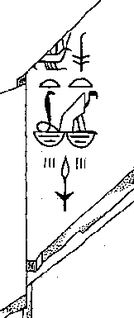
Weneg, also known as Weneg-Nebty, is the throne name of an early Egyptian king, who ruled during the second dynasty. Although his chronological position is clear to Egyptologists, it is unclear for how long King Weneg ruled. It is also unclear as to which of the archaeologically identified Horus-kings corresponds to Weneg.
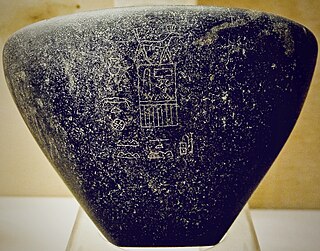
Seth-Peribsen is the serekh name of an early Egyptian monarch (pharaoh), who ruled during the Second Dynasty of Egypt. His chronological position within this dynasty is unknown and it is disputed who ruled both before and after him. The duration of his reign is also unknown.

Anedjib, more correctly Adjib and also known as Hor-Anedjib, Hor-Adjib and Enezib, is the Horus name of an early Egyptian king who ruled during the 1st dynasty. The Egyptian historian Manetho named him "Miebîdós" and credited him with a reign of 26 years, whilst the Royal Canon of Turin credited him with an implausible reign of 74 years. Egyptologists and historians now consider both records to be exaggerations and generally credit Adjib with a reign of 8–10 years.
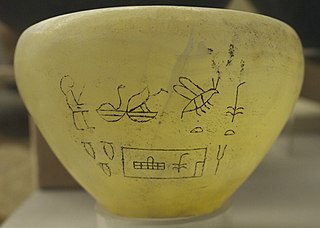
Semerkhet is the Horus name of an early Egyptian king who ruled during the first dynasty. This ruler became known through a tragic legend handed down by the ancient Greek historian, Manetho, who reported that a calamity of some sort occurred during Semerkhet's reign. The archaeological records seem to support the view that Semerkhet had a difficult time as king and some early archaeologists even questioned the legitimacy of Semerkhet's succession to the Egyptian throne.

Sekhemib-Perenma'at, is the horus name of an early Egyptian king who ruled during the 2nd dynasty. Similar to his predecessor, successor or co-ruler Seth-Peribsen, Sekhemib is contemporarily well attested in archaeological records, but he does not appear in any posthumous document. The exact length of his reign is unknown and his burial site has yet to be found.

The Horus name is the oldest known and used crest of Ancient Egyptian rulers. It belongs to the "Great five names" of an Egyptian pharaoh. However, modern Egyptologists and linguists are starting to prefer the more neutral term: the "serekh name". This is because not every pharaoh had placed the falcon, which symbolizes the deity Horus, atop his serekh.

Neithhotep or Neith-hotep was an ancient Egyptian queen consort living and ruling during the early First Dynasty. She was once thought to be a male ruler: her outstandingly large mastaba and the royal serekh surrounding her name on several seal impressions previously led Egyptologists and historians to the erroneous belief that she may have been an unknown king.
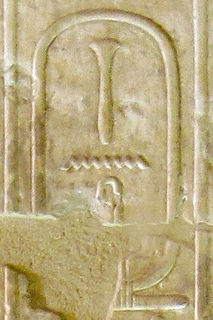
Wadjenes, also known as Wadjlas, Ougotlas and Tlas, was an early Egyptian king who may have ruled during the 2nd dynasty. Since the name form "Wadjenes" is not contemporarily attested as the name of a king, but frequently appears in Ramesside kinglists, Egyptologists to this day are trying to connect Wadjenes with contemporary Horus-kings.

Sneferka is the serekh-name of an early Egyptian king who may have ruled at the end of the 1st dynasty. The exact length of his reign is unknown, but thought to have been very short and his chronological position is unclear.

Horus Bird, also known as Horus-Ba, is the serekh-name of a pharaoh who may have had a very short reign between the 1st dynasty and 2nd dynasty of Egypt.

Horus Sa was a possible early Egyptian pharaoh who may have reigned during the 2nd or 3rd dynasty of Egypt. His existence is disputed, as is the meaning of the artifacts that have been interpreted as confirming his existence.
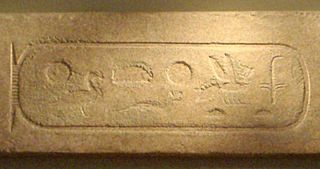
The nomen of Ancient Egyptian pharaohs was one of the "Great five names". It was introduced by king Djedefre, third pharaoh of the 4th Dynasty, as an emendation to the traditional nswt-bity crest. The nomen was later separated from the prenomen to become an independent royal name.








